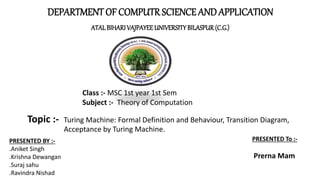
souraj Toc.pptx
- 1. DEPARTMENT OF COMPUTRSCIENCE AND APPLICATION ATALBIHARI VAJPAYEEUNIVERSITYBILASPUR(C.G.) Topic :- Turing Machine: Formal Definition and Behaviour, Transition Diagram, Acceptance by Turing Machine. PRESENTED BY :- .Aniket Singh .Krishna Dewangan .Suraj sahu .Ravindra Nishad Class :- MSC 1st year 1st Sem Subject :- Theory of Computation PRESENTED To :- Prerna Mam
- 2. Transition Diagram Acceptance by Turing Machine Turing Machine: Formal Definetion and Behaviour
- 3. Turing Machine:-- A L A N T U R I N G 2 3 J u n e 1 9 1 2 To 0 7 J u n e 1 9 5 7
- 4. INTRODUCATION TO TURING MACHINE:-- • Invented by esteemed Computer Scientist ALAN TURING IN 1936. • Basically an abstract computational model that perform computations. • Provide a powerful computational model for solving problems in computer science • Capable of simulating common computers. • It has unlimited memory capability.
- 5. Turing machine was invented in 1936 by Alan Turing. It is an accepting device which accepts Recursive Enumerable Language generated by type 0 grammar Turing machine can accept all this language T.M Recursively Enumerable LanguageT.M P.D.A Context Free LanguageP.D.A F.A Ragular LanguageF.A EX. an bn PDA an bn cn TM
- 6. Q Set of finite states ∑ finite set of I/P Alphabet not containing B READ/WRITE HEAD Γ finite set of tape symbol including (∑≤ Γ ) B Special symbol represtnting Blank cell (B ) q0 is initial state (q0 ) F Set of final state (F ≤ Q) δ A transition or mapping function. Q × Γ Q × Γ × ( L,R ) (q0, a) (q1 × X , R/L ) M=[ Q, ∑, Γ, B, q0, F, δ ] {7 tuple} Formal definition of Turing machine … B B a b a B B B … Finite control
- 7. Turing Machine has infinite size tape and it is used to accepted Recursively Enumerable Language L R TM Read also allow as well as wright is also allow TM can move in both directions [left/right] TM is a mathematical model which consists of an infinite length tape divided into cells which I/P is give if consist of a head which reads the I/P tape After reading an I/P symbol , it is replaced with another symbol it is replaced with another symbols it internal state is change it moves from one cell to the right n left A B q1 q0 q0 (state) a b b
- 8. If the TM reaches the final state I/P string accepted otherwise rejected The RULE :-- 1. You can read cell by cell 2. You can change the content to the cell 3. You can move to the right or to the left Cannot do this :-- 1. You cannot jump from a cell to a far cell just cell next to each other 2. We will give you set of thing you can use them only as input to our machine B B a b b
- 9. B B X a a Y b b B B Let us understand the approach by taking the example “aaabbb”. Scan the input from the left. First, replace an ‘a’ with ‘X’ and move right. Then skip all the a’s and b’s and move right. When the pointer reaches Blank(B) Blank will remain Blank(B) and the pointer turns left. Now it scans the input from the right and replaces the first ‘b’ with ‘Y’. Our Turing machine looks like this –
- 10. Again the pointer reaches Blank(B) or X. It now scans the input from left to right. The pointer moves forward and replaces ‘a’ with ‘X’. Again the pointer reaches Blank(B) or Y. It now scans the input from the right to left. The pointer moves forward and replaces ‘b’ with ‘y’. We repeat the same steps until we convert all the a’s to ‘X’ and b’s to ‘Y’. When all the a’s converted to ‘X and all the b’s converted to ‘Y’ our machine will halt.
- 11. accepted by Turing machine The turing machine accepts all the language even though they are recursively enumerable. Recursive means repeating the same set of rules for any number of times and enumerable means a list of elements. The TM also accepts the computable functions, such as addition, multiplication, subtraction, division, power function, and many more. Example: Construct a turing machine which accepts the language of aba over ∑ = {a, b}. Solution: We will assume that on input tape the string 'aba' is placed like this: The tape head will read out the sequence up to the Δ characters. If the tape head is readout 'aba' string then TM will halt after reading Δ.
- 12. Now, we will see how this turing machine will work for aba. Initially, state is q0 and head points to a as: The move will be δ(q0, a) = δ(q1, A, R) which means it will go to state q1, replaced a by A and head will move to right as:
- 13. The move will be δ(q1, b) = δ(q2, B, R) which means it will go to state q2, replaced b by B and head will move to right as: The move will be δ(q2, a) = δ(q3, A, R) which means it will go to state q3, replaced a by A and head will move to right as: The move δ(q3, Δ) = (q4, Δ, S) which means it will go to state q4 which is the HALT state and HALT state is always an accept state for any TM.
- 14. The same TM can be represented by Transition Table: States a b Δ q0 (q1, A, R) – – q1 – (q2, B, R) – q2 (q3, A, R) – – q3 – – (q4, Δ, S) q4 – – –
- 15. The same TM can be represented by Transition Diagram: